Zeiss Fernrohrlupen
| Im Folgenden ist mit freundlicher Genehmigung des Autors Jack Kelly sein Artikel aus der "Zeiss Historica" Zeitschrift 2002 zu lesen. Die Fotos sind wie im Original an die passende Stelle gesetzt. Alle rEchte liegen weiterhin beim Autor. | Below you find Jack Kelly's article on "Fernrohrlupen" from the Zeiss Historica 2002 magazine, which is presented here with kind permission of the author. All rights are still by the author. |
FERNROHRLUPEN
Literally translated as Telescope Magnifier, the Fernrohrlupe made its appearance in the Zeiss catalogs shortly after the introduction of the 3x Teleater binocular in 1907/08. The appeal of this device was twofold. Firstly it was a compact high quality binocular that, in the Teletur version, offered 6x magnification. Secondly, the observer had the distinct advantage of being able to use the device as a low power stereo microscope with a comfortable working distance from the subject being observed. Whereas a simple magnifier of 6 power would require the glass to be less than 1.7 inches (43 mm) from the subject, a Fernrohrlupe with the same 6 power magnification has a working distance of more than 12 inches (32 mm).
This was accomplished by adding an auxiliary set of positive diopter lenses to the front of the binocular. Applications in the fields of medicine, biology, anthropology and general nature study were immediately apparent. Enthusiastic nature lovers were now able explore the local marsh with their binoculars, comfortably observing wildlife from a distance, or, by quickly attaching the auxiliary lens, closely observe a spider on his web, from a comfortable distance. The Teleater and Teletur binoculars were apparently chosen for this application because of the close placement of the objective lenses allowing the system to be properly collimated. The much wider spacing of the objective lenses on other Zeiss binoculars of this period pretty much precluded the use of a binocular magnification system that could be reliably aligned, although a wide array of single close-up lenses were available for the 6x and 8x binoculars of the time.
According to Zeiss records, the earliest reported production of the 3x Teleater was in 1907/08 followed by the introduction of the 6x Teletur in 1909/10. The sample Teletur based Fernrohrlupe show in the accompanying illustrations bears serial number 284581 which would indicate a production date of 1911/12. The earliest record I have in my literature file is a French language catalog titled "Tele-Loupes" from 1912, distributed by the Zeiss Medical Department, and carrying the identifier "Med 3".
1. Binocular Fernrohrlupe 6x, serial number 284581 with close-up lens (detached, on the left; attached, on the right). Manufactured in 1909, it has a detachable close-up lens set and a special knob at the top of the centre hinge to mount the device on a small stand or attach it to a headband. Each of the close-up lenses incorporates a prism so that the binocular can be collimated.
The catalog is quite extensive and includes binocular models of 3x, 6x and 8x, with auxiliary lenses of +1, +3, +5, and +10 diopters. Additionally the catalog includes monocular versions of 3 or 6 power with diopter lenses of +2, 3, 4, 5 and 6. A variety of specialty stands, headbands, lights and astigmatism correcting lenses for the ocular are also listed.
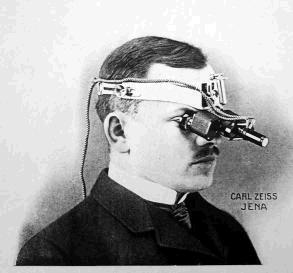
2. Binocular Fernrohrlupe mounted on boom stand (Copy of Fig. 3 Zeiss Fernrohrlupen Catalog, M3 1913)
Binocular Fernrohrlupe mounted on headband with light source (Copy of Fig 4. Zeiss Fernrohrlupen Catalog, M3 1913)
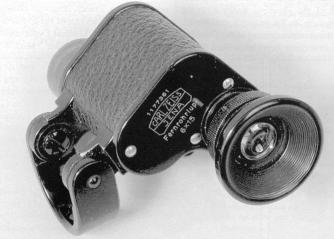
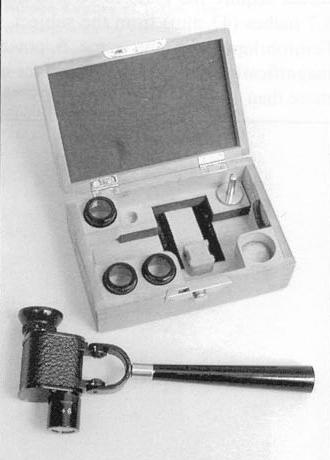
3. Monocular Fernrohrlupe 6x, with the close-up lens shown attached. On the right is the complete kit with handle and four close-up lenses. The monocular was manufactured in 1923. The handle allows the user to position the magnifier for best view or to pass it between other users. Alternatively, the device could be worn like a ring by putting a finger through the loop without the handle in place.
By 1922 an English language version of Med 3 refers to the benefits of the "Telescopic Magnifier" as "particularly useful in all those cases where it is either not practicable or desirable to bring the magnifying combination close up to the object which is to be viewed." It goes on to say that the devices have been in use, "for years in scientific institutions very diverse in character, in schools, agricultural laboratories, public offices, libraries, museums, scientific instrument workshops, engraving offices and many other establishments, in weaving and spinning mills, by zoologists, botanists, medical men, collectors and connoisseurs".
4. Monocular Fernrohrlupe mounted on microscope stand with high power objective (Copy of Fig. 16 Zeiss Pamphlet Med 3/11, 1926. Tele-microscope)
Over the years, the number of accessories available for the system increased. The design and functionality of the binocular diopter adapter also changed with time. The early versions of the binocular were clearly intended as dual-purpose devices with a centre focusing mechanism that worked effectively for the binocular as well as the binocular magnifier. By the early 1930's, the binocular was now a fixed focus system and the central focusing mechanism only focused the diopter lenses for close work.
Parallel with the production of the telescopic magnifiers, Zeiss offered close up lenses for other binoculars but only for use on one of the binocular tubes. The Turmon monocular was offered with a complete line of diopter lenses ranging from +2 to +10 diopters. In 1926 the Med 3/11 catalog included a very nice microscope base utilizing standard microscope objectives and the monocular Fernrohrlupe to provide magnifications up to 180x.
Skipping ahead to the 1980's, Zeiss Oberkoken offered a stereo microscope base for use with the 6x20, 8x20 or 10x25 binocular and providing magnifications of 12x, 16x and 20x respectively.
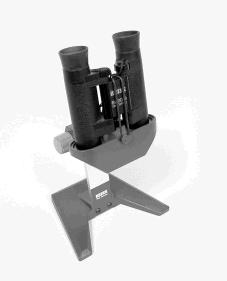
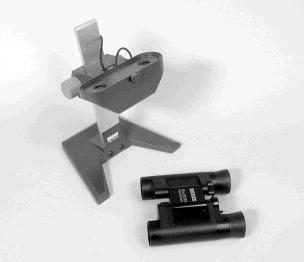
5. Zeiss 8x20B binocular and Stereo Microscope Base (attached, on the left; detached, on the right). The binocular is held in place with a rubber band assembly and the base incorporates a focusing mechanism.
Article: Zeiss Historica/J. Kelly; Fotos: J. Kelly
See also 'Catalogue MED3' in German.

